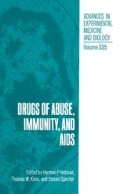Abstract
A number of structurally related cannabinoid compounds, including the major psychoactive component of marihuana, delta-9-tetrahydrocannabinol (Δ9-THC), have been widely established as being immunosuppressive. Although much has been learned with respect to which immune responses demonstrate sensitivity to modulation by cannabinoids, the mechanism(s) responsible for these effects has remained elusive. Over the past decade, significant insight has been forthcoming regarding the cellular and biochemical mechanisms which mediate the effects of cannabinoids on the central nervous system (CNS). From these investigations at least three lines of evidence have emerged which strongly implicated a role by a cannabinoid receptor in CNS association cannabinoid activity and include: (i) stereoselective effects; (ii) a high degree of specific binding by the synthetic bicyclic cannabinoid, CP-55,940, to various brain tissue preparation as analyzed by radioligand binding; and (iii) cannabinoid modulation of adenylate cyclase-cAMP second messenger system. The existence of a cannabinoid receptor in association with neuronal tissue has been recently confirmed by Matsuda and coworkers (1) through the isolation and cloning of a G-protein coupled receptor from a rat brain cDNA library. When cloned, this receptor demonstrate all of the characteristics predicted for a putative cannabinoid receptor. More recently, an almost identical receptor has been cloned from human brain which possessed more than 97% homogeneity (2) to that isolated by Matsuda and coworkers. In light of these findings, the objective of the presently reported studies was to explore the possibility that immune inhibition by cannabimimetic agents is mediated through a cannabinoid receptor present on immunocytes.
Access this chapter
Tax calculation will be finalised at checkout
Purchases are for personal use only
Preview
Unable to display preview. Download preview PDF.
References
L. A. Matsuda, S. J. Lolait, M. J. Brownstein, A. C. Young, and T. I. Bonner, Structure of a cannabinoid receptor and functional expression of the cloned cDNA, Nature, 346:561 (1990).
C. M. Gerard, C. Mollereau, G. Vassart and M. Parmentier, Nucleotide sequence of a human cannabinoid receptor cDNA, Nucleic Acids Res. ,18:7142 (1990).
A. R. Schatz, F. K. Kessler, and N. E. Kaminski, Inhibition of adenylate cyclase by -9 tetrahydrocannabinol in mouse spleen cells: A potential mechanism for cannabinoid mediated immunosuppression,Life Sci. ,51:25 (1992).
W. A. Devane, F. A. Dysarz, M. R. Johnson, L. S. Melvin, and A. C. Howlett, Determination and characterization of a cannabinoid receptor in rat brain, Mol. Pharmacol. ,34:605 (1988).
N. E. Kaminski, M. E. Abood, F. K. Kessler, B. R. Martin, and A. R. Schatz, Identification of a functionally relevant cannabinoid receptor on mouse spleen cells involved in cannabinoid-mediated immune modulation, Mol. Pharmacol. ,(submitted).
M. S. Bartlett, Sub-sampling for attributes, J. Roy. Stat. Soc, Suppl. ,4:131 (1937).
C. W. DuMett, A multiple comparison procedure for comparing several treatments with a control, J.Amer. Stat. Assoc. ,50:1096 (1955).
Gehan-Wilcoxon, in: “Survival Distributions: Reliability Applications in the Biomedical Sciences,” A. J.Gross and V. A. Clark, eds. John Wiley and Sons, New York (1975).
M. Herkenham, A. B. Lynn, M. D. Little, M. R. Johnson, L. S. Melvin, B. R. de Costa, and K. C. Rice,Cannabinoid receptor localization in brain, Proc. Natl. Acad. Sci., 87:1932 (1990).
Author information
Authors and Affiliations
Editor information
Editors and Affiliations
Rights and permissions
Copyright information
© 1993 Springer Science+Business Media New York
About this chapter
Cite this chapter
Kaminski, N.E. (1993). Evidence for a Cannabinoid Receptor in Immunomodulation by Cannabinoid Compounds. In: Friedman, H., Klein, T.W., Specter, S. (eds) Drugs of Abuse, Immunity, and AIDS. Advances in Experimental Medicine and Biology, vol 335. Springer, Boston, MA. https://doi.org/10.1007/978-1-4615-2980-4_16
Download citation
DOI: https://doi.org/10.1007/978-1-4615-2980-4_16
Publisher Name: Springer, Boston, MA
Print ISBN: 978-1-4613-6297-5
Online ISBN: 978-1-4615-2980-4
eBook Packages: Springer Book Archive

